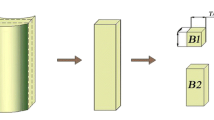Abstract
Bamboo pith ring (BPR) is regarded as a particular tissue affecting bamboo processing and is usually discarded, resulting in waste and low utilization of bamboo. To improve the utilization of bamboo and make full use of BPR, the fundamental properties, including morphology, chemical properties, and mechanical properties of BPR by confocal laser-scanning microscope, SEM, IR-image, and nanoindentation, were investigated in this study. On the macroscale, the stone cells in BPR are round or square and closely arranged, and the average thickness of BPR is 404.6 μm. On the cell scale, with the increase in distance from the pith cavity, stone cells show different shapes and sizes. On the cell wall scale, the stone cell in BPR show a multi-layer structure with alternating thick and thin walls, and there are dense pits on the wall layer. Stone cell is mainly composed of cellulose, hemicellulose, and lignin, and hemicellulose and lignin contents are higher than parenchyma cell. The elastic modulus and hardness of the stone cell wall were 6.98 GPa and 491.8 MPa, respectively. Studying BPR morphology, chemical, and mechanical properties are expected to lay a foundation for, among others, bamboo gluing, mechanics research, and drying cracking.







Similar content being viewed by others

References
Banik N, Dey V, Sastry GRK (2017) An overview of lignin & hemicellulose effect upon biodegradable bamboo fiber composites due to moisture. Mater Today: Proc 4:3222–3232
Chen L, Huang B, Wang X et al (2022) Study on gluing characteristics of bamboo pith ring. Ind Crops Prod 178:114624
Deng J, Li H, Wang G et al (2015) Effect of removing extent of bamboo green on physical and mechanical properties of laminated bamboo-bundle veneer lumber (BLVL). Eur J Wood Prod 73:499–506
Fang C-H, Jiang Z-H, Sun Z-J et al (2018) An overview on bamboo culm flattening. Constr Build Mater 171:65–74
Grosser D, Liese W (1971) On the anatomy of Asian bamboos, with special reference to their vascular bundles. Wood Sci Technol 5:290–312
He Q, Zhan T, Zhang H et al (2019) Robust and durable bonding performance of bamboo induced by high voltage electrostatic field treatment. Ind Crops Prod 137:149–156
Huang X, Huang J, Hse C et al (2019) Study on the mold-resistant properties of moso bamboo treated with starch amylase. J for Eng 4:60–65
Lian C, Liu R, **ufang C et al (2019) Characterization of the pits in parenchyma cells of the Moso bamboo [Phyllostachys edulis (Carr.) J. Houz.] culm. Holzforschung 73:629–636
Lian C, Liu R, Zhang S et al (2020a) Ultrastructure of parenchyma cell wall in bamboo (Phyllostachys edulis) culms. Cellulose 27(13):7321–7329
Lian C, Zhang S, Liu X et al (2020b) Uncovering the ultrastructure of ramiform pits in the parenchyma cells of bamboo [Phyllostachys edulis (Carr.) J. Houz.]. Holzforschung 74:321–331
Liese W, Köhl M (2015) Bamboo: the plant and its uses. Springer 8:35. https://doi.org/10.1007/978-3-319-14133-6
Liese W, Schmitt U (2006) Development and structure of the terminal layer in bamboo culms. Wood Sci Technol 40:4–15
Liese W, Tang TKH (2015) Preservation and drying of bamboo. Springer pp 257–297. https://doi.org/10.1007/978-3-319-14133-6_9
Liu W, Hui C, Wang F, et al (2018) Review of the resources and utilization of bamboo in China. Bamboo-Current and Future Prospects pp 133–142
Lou Z, Yuan T, Wang Q et al (2021) Fabrication of crack-free flattened bamboo and its macro-/micromorphological and mechanical properties. J Renew Mater 9(5):959
Özparpucu M, Gierlinger N, Cesarino I et al (2019) Significant influence of lignin on axial elastic modulus of poplar wood at low microfibril angles under wet conditions. J Exp Bot 70:4039–4047
Qisheng Z, Shenxue J, Yongyu T (2002) Industrial utilization on bamboo. International network for bamboo and rattan Bei**g, China
Sharma B, Gatóo A, Ramage MH (2015) Effect of processing methods on the mechanical properties of engineered bamboo. Constr Build Mater 83:95–101
Singh A, Dawson B, Rickard C et al (2008) Light, confocal and scanning electron microscopy of wood-adhesive interface. Microsc Anal 22:5–8
Su N, Fang C, Yu Z et al (2021) Effects of rosin treatment on hygroscopicity, dimensional stability, and pore structure of round bamboo culm. Constr Build Mater 287:123037
van Dam JE, Elbersen HW, Montaño CMD (2018) Bamboo production for industrial utilization. Perennial grasses for bioenergy and bioproducts, pp 175–216
Wang X, Zhang S, Chen L et al (2022) Effects of pith ring on the hygroscopicity and dimensional stability of bamboo. Ind Crops Prod 184:115027
Wei F, Jianqin H, Min L et al (1998) Comparative anatomy on seventeen species of tufted bamboos. J Zhejiang Agric for Univ 15:225–231
**ong W, Qiao S, Li Y (1980) Moso bamboo (Phyllostachys pubescens Mazel ex H. de Lehaie) Anatomical structure of culm. J Integr Plant Biol 4:343–348
Yu Y, Liu R, Huang Y et al (2017) Preparation, physical, mechanical, and interfacial morphological properties of engineered bamboo scrimber. Constr Build Mater 157:1032–1039
Yu Y, Tian G, Wang H et al (2011) Mechanical characterization of single bamboo fibers with nanoindentation and microtensile technique. Holzforschung 65:113–119
Yuan J, Fang C, Chen Q, Fei B (2021) Observing bamboo dimensional change caused by humidity. Constr Build Mater 309:124988
Acknowledgements
The authors gratefully acknowledge financial support from the Foundation of the International Center for Bamboo and Rattan (1632019002), and National Natural Science Foundation of China (Grant number 32230072).
Author information
Authors and Affiliations
Corresponding author
Ethics declarations
Conflict of interest
There are no conflicts of interest to declare.
Additional information
Publisher's Note
Springer Nature remains neutral with regard to jurisdictional claims in published maps and institutional affiliations.
Deceased: Benhua Fei.
Rights and permissions
Springer Nature or its licensor (e.g. a society or other partner) holds exclusive rights to this article under a publishing agreement with the author(s) or other rightsholder(s); author self-archiving of the accepted manuscript version of this article is solely governed by the terms of such publishing agreement and applicable law.
About this article
Cite this article
Chen, L., Wang, X., Huang, B. et al. Observation of the fundamental properties of bamboo pith ring. Wood Sci Technol 58, 797–810 (2024). https://doi.org/10.1007/s00226-023-01523-0
Received:
Accepted:
Published:
Issue Date:
DOI: https://doi.org/10.1007/s00226-023-01523-0



